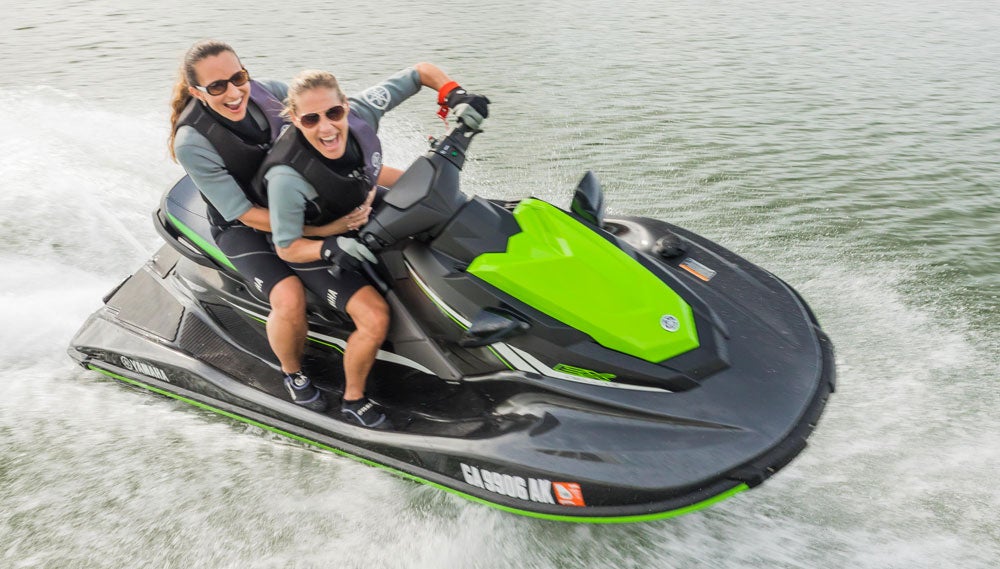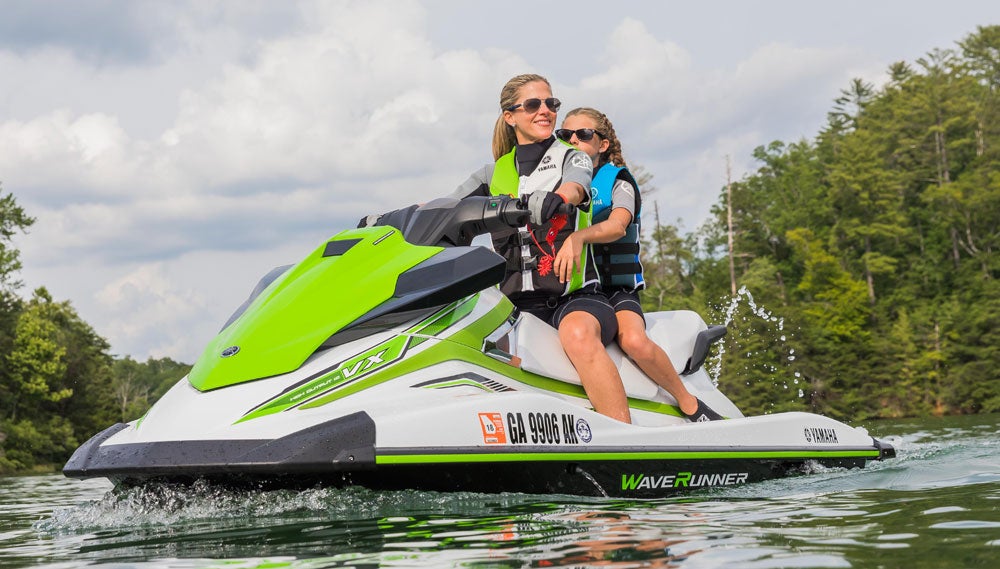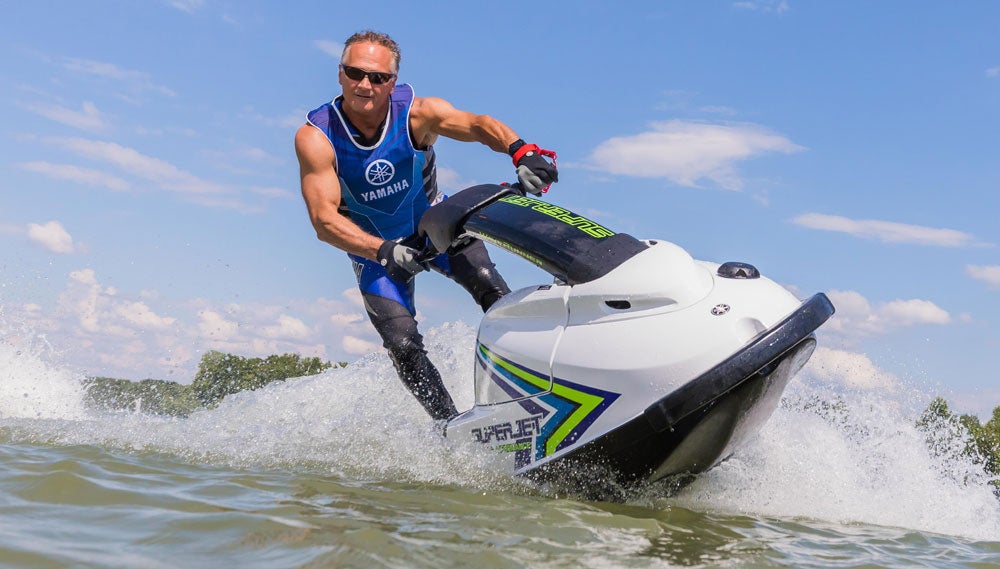2018 Yamaha WaveRunner Lineup: First Look
First, the question everyone wants answered. No, the 2018 Yamaha WaveRunner lineup did not feature any new models.
It’s to be expected. After putting a lot into the line in recent years, including the heralded RiDE system and a total new introductory lineup just last year, the company has earned the right to sit back for a season before once again ramping up the offerings in 2019. New paint and graphics are the only notable change.
Besides, the Yamaha product line is arguably the strongest it’s ever been. In an industry that’s already enjoying an 11% bump in the October 1, 2016 – July 31, 2017 sales period, the brand is enjoying its own impressive 18% increase in sales, with the VX and EX lines proving particularly strong.
Here’s a recap of the upcoming 2018 lineup…as well as a few tidbits gleaned from a factory tour provided to members of the press in mid-August.
EX Series

Introduced for the 2017 model year, the EX series continues to consist of three boats – the EX, EX Sport, and EX Deluxe. All shorter in length, lighter in weight, and more affordable than any three-passenger model the company has offered before, EX models are powered by a slightly tamed version of the 1,049cc three-cylinder TR-1 engine, a compact powerplant with exceptional fuel economy.

Hulls and decks are formed from familiar SMC fiberglass, and perform equally well at touring, towing, and cruising. The EX model is the base offering, starting at $6,699. The EX Sport adds manual reverse, mirrors, a boarding step and additional graphics for $7,699. The EX Deluxe ($8,699) increases the offerings with the electronic RiDE system, metallic paint, and a two-tone seat with more contoured cut-and-sew construction.

VX Series
Now the midrange offering in the 2018 Yamaha WaveRunner Lineup, the VX models continue to shine in sales. The VX ($9,599), VX Deluxe ($10,399), VX Cruiser ($10,699), and VX Limited ($11,099) all utilize the TR-1 engine High Output engine; the VX Cruiser HO ($11,299) opts for the high output version of Yamaha’s familiar naturally-aspirated 1.8-liter. All feature RiDE, a system that enhances low-speed control with dual throttles for forward and reverse, as well as the ability to rapidly decelerate at speed.

The Cruiser and Limited models feature Yamaha’s tiered cruiser seat, with added back support for touring enthusiasts as well as those who just enjoy a little more locked-in feel, and both cruise control and no-wake mode. The Limited adds a watersports-oriented package that includes a color-matched inflatable tube and towrope, tube inflator, tube holder, rope bag and dry bag. In addition, the boat gets a 12V plug for electronics, unique colors and graphics, four pull-up cleats, ski tow eye, and 3D Yamaha logo.

All but the base model upgrade hull construction to the lighter weight NanoXcel material, increasing the power-to-weight ratio.
Performance Race Series
The GP 1800, VXR and SuperJet all return as the performance cornerstones of the 2018 Yamaha WaveRunner lineup.
The GP 1800 ($13,999) has quickly made its mark. Combining the Super Vortex High Output variation of the supercharged 1.8-liter motor with a second-generation NanoXcel 2 hull, the craft is the epitome of power-to-weight ratio. The hull’s defined strakes, soft bow chines and race-proven keel design combine to give the craft a lean-in, aggressive ride that arguably make the craft the hardest-cornering model currently available. The RiDE system and electronic trim round out the offerings. One new addition? A “sticky” seat material to give riders better grip.

The VXR ($11,999) continues to go the naturally aspirated route, using that same 1,812cc engine but foregoing the supercharger and opting for the first generation of NanoXcel. Otherwise, it’s like the GP 1800 Lite, also offering both RiDE and electronic trim.

The SuperJet ($8,499) also returns. Shorter and lighter than the Kawasaki standup that has reentered the market, the craft is a favorite of freestyle and surf riders. The 701cc engine remains the lone two-stroke on the market.

FX Series
At the top of the food chain in the 2018 Yamaha WaveRunner lineup, the FX series continues to include the FX HO ($13,299), FX Cruiser HO ($13,799), FX SVHO ($15,299), FX Cruiser SVHO ($15,999) and FX Limited SVHO ($16,899). All feature RiDE, and five-position electronic trim control. The Limited SVHO, Cruiser SVHO and FX SVHO feature the second-generation NanoXcel 2 construction in hulls, decks, and liners. Yamaha notes the switch to Nano2 alone reduces weight of an SVHO model by 46 pounds.

SVHO models receive the supercharged Super Vortex High Output variation of the 1,812cc engine, paired with a 160mm pump and top-loader intake grate. RiDE, Cruise Assist and No Wake modes are standard issue, as is the remote transmitter that both prevents theft and activates a low RPM mode. Theater-style tiered seating highlights all Cruiser models, as well as the Limited. All offer tilt steering and multiple storage areas, including wet stowage off the aft platform.

Limited model extras include a single-passenger color-matched inflatable, towrope, inflator pump, color-matched cover with integrated solar panel battery charger, and 12V outlet located in the glovebox.

Random Observations
- Yamaha uses high-compression molding to form its hulls, decks and liners in house. The process starts with precisely placed layers of Sheet Molding Compound (SMC), placed into a massive mold. Heat, pressure and time combine to form these sheets into the rigid shapes we all know. High-compression molding has no VOC emissions, and delivers smooth, paintable surfaces with controlled tolerances.
- Curious about the difference between SMC, NanoXcel and NanoXcel 2? NanoXcel essentially replaces the bulky “filler” material in SMC with exfoliated clay, allowing the materials to be bonded together with stronger lap joints that use greater surface area than traditional butt joints. NanoXcel 2 adds glass “micro-bubbles” to develop an even stronger resin that uses less material. In real-world terms, it’s all about specific gravity and weight. SMC has a specific gravity of 1.8; NanoXcel lowers that specific gravity to 1.45 and knocks 25% off the weight of SMC; NanoXcel 2 has a specific gravity of 1.2 and is yet another 18% lighter than original Nano.
- Yamaha uses robots to spray the colors, resulting in the exceptionally smooth, consistent finish owners know and love. Why do some models get color choices and others don’t? Apparently the production number that makes it worth the added color choice is a minimum of 2,000 units. Including color choices, there are now 25 different models available in the Yamaha lineup.
- With the exception of the SuperJet, all WaveRunner models are actually built in the USA, not Japan. A total of 70% of the market is in the United States. WaveRunner models have been built in the US for the past 29 years.
- Think factory work sounds unappealing…and low pay? Consider this — Yamaha pays its workers more than 2.5-times the minimum wage. Almost 100 original employees are still working in the Newnan, Georgia plant.
- An astounding 49% of new personal watercraft sales in the October-July period went to first-time buyers.
- The used market is still big. 133,000 used PWC changed hands in 2016, but new models are now gaining more traction than used, probably a testament to the lower-priced introductory models now being offered by both Yamaha and Sea-Doo.
- Yamaha’s one millionth WaveRunner is estimated to roll off the assembly line in April 2018.
Get PersonalWatercraft.com in your Inbox!
Like PersonalWatercraft.com on Facebook
Comments
Most Popular

2025 Yamaha JetBlaster PRO 2-Up Review

Remembering the Sea-Doo XP

2024 Kawasaki Jet Ski STX 160X Review

Whatever Happened to the Wetbike?

2025 Yamaha JetBlaster Review






























 Your Privacy Choices
Your Privacy Choices